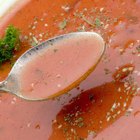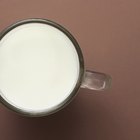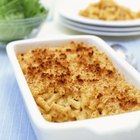
Soups can be a cook's best friend when the fridge is full of leftovers or the weather is cold and damp. Frugal home cooks and cost-conscious chefs are equally happy to turn cooked vegetables and a few cups of milk or cream into a warm and satisfying cream soup. Unfortunately, sometimes those soups will sour or curdle, spoiling their appearance and sometimes their flavor. Usually that's the result of an easily corrected error in your soup-making technique.
Heat
Milk and cream include varying amounts of fat and protein. Milk contains lots of protein, making it prone to curdling, while high-fat cream is relatively resistant to curdling. When a dairy product curdles, it's because the molecules of protein have contracted and tightened together. That's the same reaction you see when a steak or a strip of bacon shrivels at the edges during cooking. In dairy products, the proteins form small, grainy curds and leave behind a pool of watery whey. Heating the milk too quickly is the usual cause. When you add milk to your cream soups, whisk the hot broth slowly into your milk until it's hot. Never let the soup boil after milk's been added.
Freshness
Even if you've added your milk and cream slowly, sometimes they'll curdle at temperatures well below the boiling point. Often, that's because they're not as fresh as they should be. Sometimes your milk is on the verge of souring, but still smells fine when you sniff it casually. When you heat that milk or cream, it will curdle and sour in the soup.
Acidity
Milk becomes sour because harmless bacteria convert its natural sugars to acetic and lactic acid. The combination of heat and acidity has an immediate and powerful effect on dairy products, often curdling them in seconds. Aside from milk that's past its prime, you can easily make your soups too acidic by adding ingredients such as tomatoes or wine. They should be avoided or added just before serving your soup.
Cooling and Storage
Sometimes your soup is fine when you serve it initially, but sours and curdles when you reheat the leftovers a few days later. That's usually because you haven't cooled the soup quickly enough before refrigerating it, allowing bacterial growth. Divide your leftover soup into small, flat containers to cool it efficiently. Placing the sealed containers in a sink of cold water is an effective cooling method, especially if the water is changed regularly. The soup should be in your fridge within two hours or less, and chilled to a food safe temperature -- 40 degrees Fahrenheit or lower -- within another two hours.
Be Proactive
Avoiding those mistakes is helpful, but there are also proactive steps you can take. For example, you can simmer your cream ahead of time to concentrate it, making it more stable. Alternatively, thicken your milk and cream ahead of time with cornstarch or quick-mixing flour. The starch stabilizes your milk, keeping it from curdling the soup. Professionals use roux -- a mixture of butter and flour, cooked together -- to thicken broth or milk for soups, which produces a similarly stable result. In fact, the soups are stable enough that chefs can often "brighten" their flavor at the last minute by adding acidic ingredients such as lemon juice or buttermilk.
Related Articles

How to Make a Cream Soup Without ...

Why Does Milk Curdle When Baking a ...

Do You Use Flour or Corn Starch to ...

What Happens if You Whip Condensed Milk?

Can You Make Cream Soups Hours Before ...

Why Does Milk Curdle When it Is Mixed ...

Can You Make Chicken Fettuccine Alfredo ...

Why Does a Sauce Curdle?

Easy Stews to Freeze

Low Sodium Substitute for Condensed ...

How to Get Half & Half to Thicken

Can You Bake Greek Yogurt?

Can I Freeze Split Pea Soup With Ham ...

How to Make Celery Soup

Why Does Milk Turn Yellow When It ...

Can You Use Milk Instead of Cream for ...

How to Make Scalded Cream

How to Cook Stew in a Slow Cooker

How to Thicken Cream Filling

How to Scald Milk for Cooking
References
- On Food and Cooking: The Science and Lore of the Kitchen; Harold McGee
- On Cooking: A Textbook of Culinary Fundamentals; Sarah Labensky, et al.
- Recipe Tips: Prevent Soups From Curdling
Writer Bio
Fred Decker is a trained chef and certified food-safety trainer. Decker wrote for the Saint John, New Brunswick Telegraph-Journal, and has been published in Canada's Hospitality and Foodservice magazine. He's held positions selling computers, insurance and mutual funds, and was educated at Memorial University of Newfoundland and the Northern Alberta Institute of Technology.
Photo Credits
Creatas Images/Creatas/Getty Images